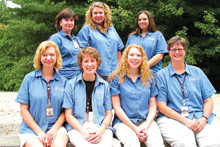Move over, Martha Stewart. The power behind the flowers at Biltmore House is a group of women with more than 75 years’ worth of collective experience in floral design and horticulture.

They’re the full-time floral ladies, a funny, engaging, warm and lively group of women who tend to answer questions in unison: Becky Lance, Jennifir (“with an ‘i’”) Huston, Molly Hensley, Mary Quirk, Jennifer Bateman, Gloria Brank and Susan Partain. I had a blast visiting them at the estate last month. If you want to learn how to do something, go to the experts, and I wanted to learn how to arrange flowers. These women dedicate hours of research and creative thought both to preparing for special events and arranging the everyday flowers enjoyed by visitors to Biltmore House.
I laughed as they shared their favorite questions from guests. “Do you do deliveries?” Their tongue-in-cheek response was based on where the questioner lives. If it’s Florida and it’s winter—absolutely. if it’s Florida and it’s steamy August—you’re out of luck.
“Can I have your job?” Depends on the day, they said in unison.
“Can you decorate my house?” Sure, just as soon as they finish with Biltmore (which contains a mere four acres within its walls).
“Do you get to cut flowers from the estate?” Yes, they have cutting privileges on the 8,000-acre property—which alone is enough to make the rest of us green with envy.
When asked how they got their jobs, the answers come fast: a lot of hard work, study, experience, a desire to work in an unparalleled environment, a passion to be the best—oh, and applying for the job in the first place.
“Do you decorate your own homes?” I asked. Yes, they said, but they don’t stop there. They also lend their talents to their churches, civic groups, weddings, and—every year, without fail—a Hospice Tree. For each of these women, their job is their life and their life is their job. They call their workspace the “floral warehouse”; it’s crammed ceiling-high with boxes, books and tables overflowing with projects.
Turns out they’re flower snobs, automatically checking out the flower arrangements at other places and critiquing them. It’s one of the drawbacks of the job, a habit born of cranking out anywhere from five to 12 floral arrangements a day. But a vase of daises on your dining-room table still warms their hearts, they’re quick to say. And they’re excited to think that their designs might inspire you to try your own.
Their favorite flowers surprised me. I was expecting exotic names I’d never heard of, but all the women tend to favor the simple and easy-to-grow. Gloria likes ferns, Becky adores zinnias; Jennifir loves bells of Ireland, Molly likes dahlias, Susan goes for lilies of the valley, Mary loves her orange lilies, and Jennifer reminisces about gardenias.
Their other passions are the research, planning and end results of their labors. Every event at Biltmore has a theme: For this spring’s Festival of Flowers, for example, the floral team came up with the idea of re-creating the flavor of Vanderbilt daughter Cornelia’s 25th birthday party, which had an Oriental theme. They’ve already decided what they’re doing next spring, but you’ll have to wait and see. Meanwhile, each woman also meticulously plans the individual rooms she’s assigned.
Toward the end of our interview, I asked for a how-to on floral arrangements. They talked so fast, in unison, that I asked for a printout. Thank goodness they had one! So here are some tips from the floral ladies at Biltmore on doing great floral designs at home:
• Take inspiration from nature—look for plants with character, texture, variegation, color and movement (think twigs, stems and vines here).
• It’s not just about the flowers. Branches from trees and shrubs are good (remember to cut at the joint). Herbs add fragrance, grains suggest bounty, and wildflowers can give a feel for the season.
• Cut flowers in various stages, from tight to just-opening buds to fully open blooms and even seedpods.
• Cut early, before the dew dries.
• Pruners should be sharp and clean to prevent shredding, tearing or damaging the plant’s ability to absorb water. Place plants in a bucket of tepid water immediately so the stems don’t dry out or close up. Add a conditioner (one part Sprite, five parts water and one-quarter part bleach) to keep plants bacteria-free.
• Cut stems at a sharp angle, 1 to 2 inches up the stem. This keeps it from resting flat on the bottom of the container.
• Remove foliage below the water line.
• Place flowers in a cool, dark, humid place, and condition for four to eight hours. This allows the plant to draw as much water as possible, making for longer-lasting arrangements.
• Choose a suitable container for the arrangement, and then consider what size it needs to be.
• Don’t let the greenery overpower the flowers: You want to be able to see each one.
• Re-cut the stems as you arrange.
• Keep it simple: Let the flowers do what they do.
• Don’t overwork your arrangement. Follow the natural design of the plants.
Finally, enjoy your flowers and have fun arranging them. Let unexpected combinations happen. While these talented women sat at a worktable discussing Victorian flower arrangements, I couldn’t help but notice that the only one in sight was a vase containing five or six zinnias.
Even at Biltmore, a small vase of some simple flowers placed in just the right corner can brighten the entire room.
[Cinthia Milner lives in Leicester.]



Even though I may be a bit biased because Jennifir (with an i) is my daughter, these gals really are magnificent. If you have never been to the Biltmore House, it is worth the trip just to see the floral arrangements. Simply amazing.